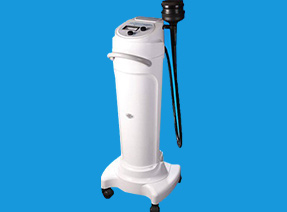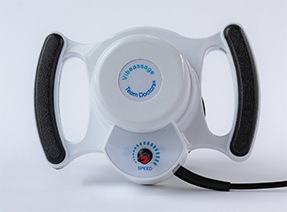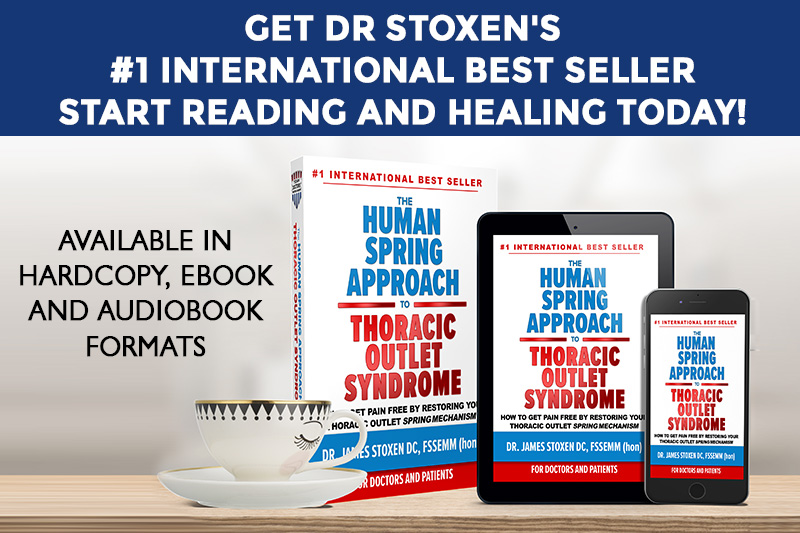THE HUMAN SPRING APPROACH TO
THORACIC OUTLET SYNDROME
by Dr James Stoxen DC., FSSEMM (hon) FWSSEM
GLOSSARY
T
temporomandibular joint (TMJ) – the hinge joint between the temporal bone and the lower jaw.
temporomandibular joint dysfunction – temporomandibular joint dysfunction (TMD, TMJD) is an umbrella term covering pain and dysfunction of the muscles of mastication (the muscles that move the jaw) and the temporomandibular joints (the joints which connect the mandible to the skull).
tendonitis – inflammation of a tendon.
tension headaches – a tension headache is the most common type of headache. This type of headache can cause mild or moderate pain in the head, neck, and behind the eyes. Some patients say that a tension headache feels like a tight band around their foreheads.
tension neck syndrome – also called text neck syndrome, tech neck syndrome and tension neck syndrome which include neck tightness, muscle spasms, muscle stiffness and difficulty turning the head in certain directions. This pain worsens in certain positions.
Thai massage – traditional Thai massage is a combination of acupressure, reflexology and yogic exercises, or gentle stretching, which manipulates the energy lines and so diminishes tension, stimulates metabolism and creates a feeling of well being and vitality.
The Controlled Substances Act (CSA) – the statute prescribing federal U.S. drug policy under which the manufacture, importation, possession, uses and distribution of certain substances is regulated.
thecal sac – the thecal sac or dural sac is the membranous sheath of dura mater that surrounds the spinal cord and the cauda equina.
therapeutic massage – therapeutic massage involves the manipulation of the soft tissue structures of the body to prevent and alleviate pain, discomfort, muscle spasm, and stress; and, to promote health and wellness. AMTA defines Massage as, “a manual soft tissue manipulation that includes holding, causing movement, and/or applying pressure to the body.
thoracic – of or relating to the thorax.
thoracic area – the thoracic spine is located in the chest area and contains 12 vertebrae. The ribs connect to the thoracic spine and protect many vital organs.
thoracic artery syndrome – there is no such syndrome
thoracic compartment syndrome – this is another name for thoracic outlet syndrome
thoracic duct lymph leak – the leakage of intestinal lymphatic fluid from the thoracic duct (TD) and its tributaries, or intestinal lymphatic ducts. The cause can be either traumatic (thoracic surgery) or nontraumatic (idiopathic, malignancy).
thoracic inlet (outlet or compartment) – the passageway leading from the base of the neck defined by your first rib at the floor and your collarbone as the roof. This area allows the passage of the blood vessels and nerves from the thorax and neck to the arm.
thoracic medicine – known also as Chest medicine or Respiratory medicine, is a specialty of medicine which deals with investigation and treatment of diseases of the lungs.
thoracic myalgia – myalgia, or muscle pain, is a symptom of many diseases and disorders. The most common causes are the overuse of a muscle or group of muscles.
thoracic nerve – any of 12 mixed motor and sensory nerves on each side of the spine, supplying muscles and skin of the thoracic and the abdominal walls.
thoracic nerve impingement – (thoracic nerve entrapment)a pinched nerve in the thoracic spine.
thoracic outlet anatomy – the anatomy of the thoracic outlet and surrounding region
thoracic outlet (inlet or compartment) – the passageway leading from the base of the neck defined by your first rib at the floor and your collarbone as the roof. This area allows the passage of the blood vessels and nerves from the thorax and neck to the arm.
thoracic outlet compression – compression of the space created by the shoulder above and the ribs below that allow the safe passage of blood vessels and nerves from the thorax to the arm
thoracic outlet compression (TOS, thoracic outlet syndrome) – a condition caused by compression of nerves or blood vessels in the thoracic outlet the passageway leading from the base of the neck defined by your first rib at the floor and your collarbone as the roof.
thoracic outlet compression syndrome (TOCS) – another name for thoracic outlet syndrome.
thoracic outlet decompression – treatment may involve non-surgical manual therapy, stretches, and exercises. The surgical decompression of the thoracic outlet may involve the removal of the first rib or an anomalous rib, partial removal of the anterior and middle scalene muscles, and decompression of the brachial plexus.
thoracic outlet disorder (TOS, thoracic outlet syndrome) – a condition caused by compression of nerves or blood vessels in the thoracic outlet the passageway leading from the base of the neck defined by your first rib at the floor and your collarbone as the roof.
thoracic outlet surgery – transaxillary, supraclavicular and tinectomy surgery are the types of thoracic outlet surgeries.
thoracic outlet syndrome (TOS) (thoracic inlet syndrome) – what is thoracic outlet syndrome? It is a condition caused by compression of nerves or blood vessels in the thoracic outlet the passageway leading from the base of the neck defined by your first rib at the floor and your collarbone as the roof.
thoracic outlet syndrome acupuncture – acupuncture for thoracic outlet syndrome.
thoracic outlet syndrome causes – these are the causes of thoracic outlet syndrome such as posture or a traumatic shift in bone position from a car accident or work injury.
thoracic outlet syndrome diagnosis – based on the history, symptoms and signs that it is thoracic outlet syndrome.
thoracic outlet syndrome disability – when someone is disabled and cannot do their work because of thoracic outlet syndrome or the complications of thoracic outlet syndrome
thoracic outlet syndrome exercises – exercises specifically to increase resting tone of the muscles to open the thoracic outlet wider to allow a safe passage of the blood vessels and nerves from the neck and thorax to the am through the thoracic outlet and tunnel.
thoracic outlet syndrome exercises to avoid – exercises that cause an imbalance in strength that leads to a narrowing of the thoracic outlet and tunnel.
thoracic outlet syndrome ICD-10-CM is G54.0
thoracic outlet syndrome pain – the pain pattern associated with thoracic outlet syndrome.
thoracic outlet syndrome pain pattern – is the pattern of the regional and radiating pain from thoracic outlet syndrome.
thoracic outlet syndrome physical therapy – physical therapy to reduce the compression of the blood vessels and nerves in the thoracic outlet.
thoracic outlet syndrome pitchers – baseball pitchers that have acquired thoracic outlet syndrome
thoracic outlet syndrome physical therapy – physical therapy used to treat thoracic outlet syndrome.
thoracic outlet syndrome prognosis – the likely course of thoracic outlet syndrome with a particular course of care.
thoracic outlet syndrome rehabilitation exercises – (thoracic outlet syndrome rehab) exercises to correct weakness and imbalances around the thoracic outlet that can cause shifting of the ribs up into the outlet and shifting of the shoulder girdle down into the outlet. The purpose of the thoracic outlet syndrome rehabilitation exercises is to strengthen the muscles that open the thoracic outlet and widen the tunnel where the nerves and blood vessels pass into the arm.
thoracic outlet syndrome stretches – stretches that are helpful to open the thoracic outlet.
thoracic outlet syndrome surgery – surgery to remove the cause of the compression of the blood vessels and nerves.
thoracic outlet syndrome surgery complications – complications from surgery for thoracic outlet syndrome.
thoracic outlet syndrome symptoms – symptoms caused by compression of your thoracic outlet space.
thoracic outlet syndrome tests – tests that check for the signs of compression of the blood vessels and/or nerves in the thoracic outlet.
thoracic outlet syndrome treatment – (thoracic outlet syndrome therapy) treatment to reduce the compression of the blood vessels and nerves in the thoracic outlet.
thoracic outlet tests – tests to determine the integrity of the thoracic outlet
thoracic plexus disorder – there is no such thing as thoracic plexus disorder.
thoracic pain – upper back pain, also called middle back pain or thoracic back pain, is back pain that is felt in the region of the thoracic vertebrae, which are between the bottom of the neck and top of the lumbar spine.
thoracic rib pain – pain in the ribs in the thorax can be between the shoulder blades, in the chest, breastbone, upper back, lower neck and in the flanks. This pain can be accompanied by difficulty breathing.
thoracic ribs – the thoracic ribs are the 12 ribs that attach in the front to the sternum and in the back to the thoracic spine
thoracic spine – thoracic vertebrae are the twelve vertebral segments (T1-T-12) that make up the thoracic spine
thoracic spine pain (upper back pain, also called middle back pain or thoracic back pain) – back pain that is felt in the region of the thoracic vertebrae, which are between the bottom of the neck and top of the lumbar spine.
thoracic tunnel (thoracic outlet, inlet or compartment) – the passageway leading from the base of the neck defined by your first rib at the floor and your collarbone as the roof.
thorasicus longus nerve (long thoracic nerve, external respiratory nerve of Bell, posterior thoracic nerve) – the nerve that supplies the serratus anterior muscle that is susceptible to damage during surgery to decompress the thoracic outlet resulting in winging of the scapula.
thorax – the part of the body of a mammal between the neck and the abdomen, including the cavity enclosed by the ribs, breastbone, and dorsal vertebrae, and containing the chief organs of circulation and respiration; the chest.
thrombectomy – thrombectomy is a surgical procedure used to remove deep thrombosis, or blood clots that have formed in the deep veins.
thrombolysis – thrombolysis is the breakdown (lies) of blood clots by pharmacological means, and commonly called clot busting. It works by stimulating secondary fibrinolysis by plasmin through infusion of analogs of tissue plasminogen activator (tPA), the protein that normally activates plasmin.
thrombolytic therapy – the use of drugs to break up or dissolve blood clots, which are the main cause of both heart attacks and stroke.
Thrombophilia – a condition where your blood has an increased risk to form blood clots.
thrombosis – local coagulation or clotting of the blood in a part of the circulatory system.
thrombus – a clot of blood formed within a blood vessel and remaining attached to where it formed.
Tiagabine – anticonvulsive drug that has been tried for the nerve pain in treatment of TOS.
tic – a sudden, repetitive, nonrhythmic motor movement or vocalization involving discrete muscle groups.
tinels sign – what you find with a positive carpal tunnel test
tingling – experience or cause to experience a slight prickling or stinging sensation.
titan proteins – Titin also known as connectin, is a protein that, in humans, is a giant protein that functions as a molecular spring. It is responsible for the passive elasticity of muscle.
tizanidine – muscle relaxant drug used to relax muscle spasms that exacerbate thoracic outlet syndrome.
TMJ dysfunction (temporomandibular joint dysfunction) (TMD, TMJD) – an umbrella term covering pain and dysfunction of the muscles of mastication (the muscles that move the jaw) and the temporomandibular joints (the joints which connect the mandible to the skull).
tonic contraction – sustained contraction of a muscle, as employed in the maintenance of posture.
tonic sustained contractions – sustained contraction of a muscle, as employed in the maintenance of posture.
tonus – is a partial contraction of the muscles, or the muscle’s resistance to passive stretch during resting state.
Topiramate – anticonvulsive drug that tried for the nerve pain in treatment of TOS.
torsion spring – A torsion spring is a spring that works by torsion or twisting; that is, a flexible elastic object that stores mechanical energy when it is twisted.
torn rotator cuff pain – a rotator cuff tear can cause a dull ache in the shoulder, which is often painful when you try to sleep on the involved side.
torsional – the twisting of a body by two equal and opposite torques.
TOS – the abbreviation for thoracic outlet syndrome.
TOS decompression surgery – surgery for thoracic outlet syndrome.
TOS surgery – surgery for thoracic outlet syndrome.
TOS syndrome – there is no such thing as TOS syndrome. There is thoracic outlet syndrome and TOS.
TOS symptoms – symptoms caused by thoracic outlet syndrome.
TOS test – Tests to differentially diagnose thoracic outlet syndrome from other conditions
toxic stimuli – the definition of noxious is something very unpleasant or something poisonous.
traction – the application of a sustained pull on a body part.
traditional medicine – The World Health Organization defines traditional medicine as “the sum total of the knowledge, skills, and practices based on the theories, beliefs, and experiences indigenous to different cultures, whether explicable or not, used in the maintenance of health as well as in the prevention, diagnosis, improvement or treatment of physical and mental illness”.
Tramadol – an opioid pain medication used to treat moderate to moderately severe pain. When taken by mouth in an immediate-release formulation, the onset of pain relief usually occurs within an hour.
transaxillary surgery approach – a surgical approach for the decompression of the thoracic outlet where an incision in the armpit. Transaxillary operations are ideal for operating near the lower brachial plexus.
transcutaneous electrical nerve stimulation TENS – transcutaneous electrical nerve stimulation (TENS). a method of pain control by the application of electric impulses to the nerve endings.
Tricyclic antidepressants (Tricyclic, tetracyclic antidepressants, cyclic antidepressants) – the earliest antidepressants developed. Cyclic antidepressants block the absorption (reuptake) of the neurotransmitters serotonin and norepinephrine increasing the levels of these two neurotransmitters in the brain. Cyclic antidepressants also affect other chemical messengers, which can lead to a number of side effects.
trigger point (active) – is a trigger point that is painful without stimulation. Palpation will reproduce the patient’s symptoms.
trigger point (latent) – a focus of hyperirritability in a muscle taut band that is clinically associated with local twitch response and tenderness and/or referred pain upon manual examination.
trigger point therapy – is also known as Myotherapy or Neuromuscular Therapy and applies concentrated finger pressure to “trigger points” (painful irritated areas in muscles) to break cycles of spasm and pain.
trigger points – a sensitive area of the body, stimulation or irritation of which causes a specific effect in another part, especially a tender area in a muscle that causes generalized musculoskeletal pain when over stimulated.
trigger-point injections – a trigger point injection is an outpatient procedure where by substances are injection in the muscle trigger points to reduce or relieve pain and reduce abnormal tension.
triple crush – compression or local irritation of a peripheral nerve at 3 sites along its course.
true neurogenic thoracic outlet syndrome (NTOS) – a rare disorder with an estimated incidence of 1 per million. NTOS is more common in females and presents with slowly progressive weakness of the intrinsic hand muscles.
true neurogenic thoracic outlet syndrome TOS – is an uncommon disease and is difficult to diagnose at the early stage and then completely cure.
true, disputed, or nonspecific NTOS: – terms used by some who think that NTOS is rigorously defined only by objective nerve conduction abnormalities or hand muscle atrophy (“true” if present, “disputed” or “nonspecific” if not).
tui na – involves massaging the body’s soft connective tissues helping joint movement and is a form of acupuncture without needles.
turbulence – violent or unsteady movement of air or water, or of some other fluid.
twitch (twitching) – give or cause to give a short, sudden jerking or convulsive movement.

Meet Dr James Stoxen DC., FSSEMM (hon)
President, Team Doctors® Masters Academy
www.drstoxen.com
Dr Stoxen’s Curriculum Vitae
Stay connected to our thoracic outlet syndrome social media sites
1.1k
Members

READ THESE CHAPTERS OF DR STOXENS BOOK FREE HERE!
ARTICLE CATEGORIES
- Testimonials (13)
- Success Stories (13)
- Failed TOS Surgery (1)
- Thoracic Outlet Syndrome (11)
- Compartment Syndrome – Forearm (5)
- Shoulder Replacement Surgery (1)
- Cervical Discectomy (1)
- Cervical Fusion Surgery (1)
- What is TOS? (3)
- Thoracic Outlet Anatomy (1)
- Thoracic Outlet Engineering (1)
- Causes Of TOS (6)
- The TOS Examination (1)
- Diagnostic Tests for TOS (1)
- What Mimics TOS? (1)
- Paget-Schroetter Syndrome (2)
- TOS Surgery (2)
- Posture Tips (1)
- Self Treatment (1)
- What doesn’t work and why? (1)
- What works and why? (1)
- Stretches for TOS (1)
- Exercises for TOS (1)
- Surgery for TOS (1)
- Case Studies (2)
- Chapter Reviews (10)
- Uncategorized (16)
VIDEO TUTORIALS
Subscribe to our newsletter
Team Doctors® Master’s Academy
Professional Development Courses
Launching January 1, 2022!
Team Doctors® Master’s Academy
Patient Self-Care Workshops
Launching January 1, 2022!


















